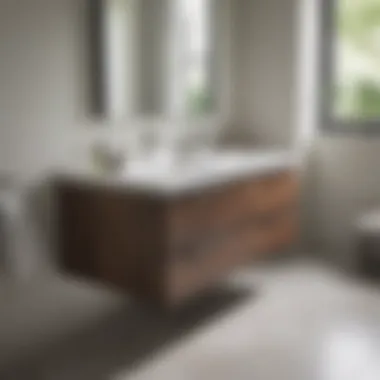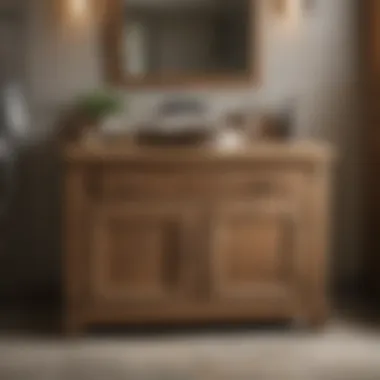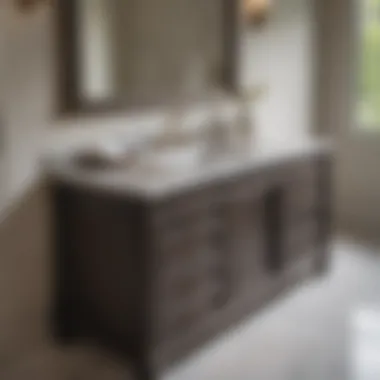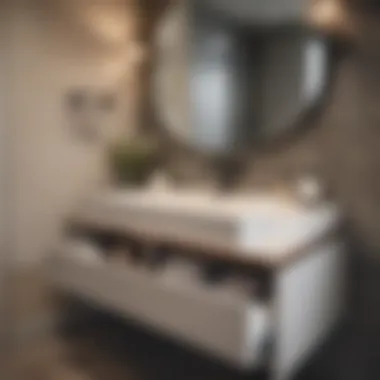Comprehensive Guide to Cabinet Style Bathroom Vanities


Intro
When it comes to refreshing your bathroom, selecting the right cabinet style vanity is as crucial as picking the perfect towel set. These vanities blend beauty with utility, creating more than just storage—they shape the overall vibe of the room. This guide aims to peel back the layers of cabinet style bathroom vanities, diving into design aesthetics, materials, and installation tips that can make or break a project. As trends shift and evolve, knowing what’s out there is imperative for homeowners, interior designers, and DIY aficionados alike.
In this exploration, we will dissect various furniture styles and trends, provide practical advice for selecting the ideal vanity, and offer insights into maintenance to keep your investment looking fresh and chic. Whether you embrace a modern twist or lean towards traditional charm, this comprehensive pathway leads to your best bathroom yet.
Understanding Cabinet Style Bathroom Vanities
Understanding cabinet style bathroom vanities goes beyond simply knowing what they are, it’s about grasping their significance in enhancing the overall bathroom experience. Vanities are often the focal point of a bathroom, pulling together style, function, and comfort. A crucial component in interior design, they can dramatically affect how a space feels and operates. By comprehending their essence, homeowners and designers can make informed choices that align with their aesthetic vision and practical needs.
Definition and Purpose
Cabinet style bathroom vanities serve as versatile focal points in a bathroom. They typically consist of a cabinet structure that supports a countertop and sink. This setup provides essential storage while also acting as a place for grooming and hygiene rituals. The primary purpose goes beyond rudimentary storage; it holds the sink, thus serving as a functional centerpiece that encourages both organization and cleanliness. Moreover, they are designed to withstand moisture and use, ensuring that the bathroom remains a well-ordered space.
The appeal of these vanities lies in their combination of practicality and style. They allow for personal expression, with various designs available to suit different tastes. Whether someone prefers the sleek lines of modern styles or the warm, inviting look of rustic cabinets, there’s something for everyone. They also offer an efficient use of space, crucial for smaller bathrooms where storage can be a challenge.
Historical Context
Historically, bathroom vanities have evolved along with the concept of the bathroom itself. In centuries past, bathrooms were often cramped and utilitarian. The vanities were merely functional, lacking in design or versatility. However, with the rise of home decoration and the changing perception of bathrooms as personal sanctuaries, vanities transitioned into statement pieces.
During the Victorian era, ornate styles began to emerge, reflecting the wealth and status of homeowners. Fast forward to the mid-20th century, when minimalism started to reshape residential design, favoring simpler forms and functionalities. Today, cabinet style vanities reflect a myriad of influences, from contemporary to traditional, and each style tells a story about changing tastes and lifestyles.
Current Trends
In recent years, the cabinet style bathroom vanity has seen a surge in innovative designs and materials. People are increasingly inclined to select vanities that harmoniously blend with their personal style while offering greater functionality. Some noteworthy trends include:
- Floating Vanities: These give an illusion of more space, creating a modern aesthetic.
- Bold Colors: Homeowners are stepping away from conventional whites and wood tones, opting instead for vibrant blues, greens, or even deep blacks that make a statement.
- Mixed Materials: The combining of wood with metal or glass elements introduces a layer of texture.
- Smart Features: Incorporating technology, such as built-in charging stations or LED lighting, caters to the needs of today’s tech-savvy homeowners.
The growing emphasis on sustainability is also influencing current trends. More consumers are choosing eco-friendly materials, recognizing the value of responsible shopping.
"The bathroom is where harmony between function and style can truly thrive; understanding this balance is essential in designing a space that feels as good as it looks."
In the context of this comprehensive guide, understanding cabinet style bathroom vanities not only enriches a homeowner’s decision-making process but also invites interior designers and DIY enthusiasts to think critically about how each element influences the larger bathroom space.
Design Elements of Cabinet Style Vanities
When it comes to designing a bathroom, the cabinet style vanity can truly be the heart of the space. Its prominence impacts both the aesthetic appeal and functional organization of the room. Understanding the design elements of cabinet vanities will not only enable homeowners to choose wisely but also guide designers and DIY enthusiasts in creating tailored spaces that resonate with personal style and practicality.
Cabinet Types and Configurations
Choosing the right cabinet type is paramount to the overall function and flow of a bathroom. Generally, vanities come in several configurations, each suited to different spaces and tastes:
- Single Vanity: Perfect for smaller bathrooms, this option provides a compact solution while maximizing counter space. Ideal for minimalistic designs or powder rooms.
- Double Vanity: This configuration suits larger bathrooms or shared spaces well, offering more countertop area and sink options. It facilitates a smoother morning routine for couples or siblings.
- Wall-Mounted Vanity: For a modern feel, wall-mounted cabinets lend a sleek appearance and create an illusion of more space. They can be incorporated into smaller bathrooms with clever open shelving underneath.
- Corner Vanity: An often-overlooked option, corner vanities, maximize usable space in tighter layouts, allowing for creativity in configuration.
Understanding these types assists in maximizing functionality while maintaining a coherent design theme, ensuring the vanity not only looks good but also serves its purpose.
Color and Finish Options
The choice of color and finish on a cabinet style vanity can communicate the desired ambiance of a bathroom. Common options include:
- Traditional Woods: Natural finishes such as oak or mahogany evoke a sense of warmth and handcrafted charm.
- Bold Colors: Shades like navy, forest green, or deep red are finding their way into contemporary bathrooms. These choices create statement pieces, attracting attention right away.
- Matte vs. Glossy Finishes: Glossy surfaces can help reflect light and complement a well-lit space, while matte finishes provide a subtle, safeguarded elegance against wear and tear.
Selecting the right hue and texture not only harmonizes the surroundings but can also play a role in creating an illusion of space. Light colors often make a small bathroom feel bigger, while darker hues can add depth and luxury.
Countertops: Material Choices
Countertops are the crowning glory of any vanity. They have to stand the test of time and everyday use. Key materials commonly used include:
- Granite: Renowned for its durability and resistance to scratches, it also comes with a variety of patterns. It's a practical choice, adding a touch of luxury.
- Quartz: As a man-made material, quartz offers a non-porous surface, resisting stains and bacteria effectively. Its versatility in design makes it a popular choice among homeowners.
- Marble: While stunning, it's essential to note that marble can be prone to scratches and stains. Unique veining can elevate the aesthetics, making it a top choice for high-end designs.
By evaluating the best material for usage, maintenance, and visual appeal, one can ensure that the bathroom vanity withstands both practical demands and personal style.
"The design elements of cabinet style vanities can significantly influence the ambiance and functionality of a bathroom space, making informed choices crucial to a successful renovation or build."
Functional Aspects of Bathroom Vanities
Understanding the functional aspects of bathroom vanities is crucial for selecting the right style and layout that serves both aesthetic and practical purposes. These vanities must balance functionality with everyday use and contribute to a well-organized space in one of the busiest areas of a home. When considering any cabinet style vanity, it's important to explore how they can cater to storage needs, ergonomic considerations, and the integration of modern technology.


Storage Solutions
Think about the chaos that often reigns in a bathroom. From toiletries to towels, space can quickly become cluttered. This is where effective storage solutions provided by well-designed vanities come into play.
- Cabinet Space: Traditional cabinets can hold everything from shampoos to spare toilet paper rolls. Understanding the layout and depth of each cabinet is vital. It can make a mundane bathroom feel organized or like a whirlwind of stuff.
- Drawers & Shelving: Many vanities come equipped with drawers that slide out smoothly. They not only offer easier access but also keep smaller items like brushes and cosmetics neatly tucked away.
- Open Shelving: For those who prefer a more aesthetic look, some vanity styles include open shelving. This provides a space for decorative items and easy access to often-used products, making it a practical choice for quick retrieval.
Choosing a vanity that maximizes storage potential can transform the way a bathroom functions, making morning routines less about scrambling and more about efficiency.
Ergonomics and Accessibility
Next comes the notion of ergonomics and accessibility. A vanity isn't just about good looks; it must accommodate the needs of its users.
- Counter Height: A critical factor is the counter height of a vanity. Ideally, it should be at a level that minimizes strain during use. Standard heights vary, but selecting a height tailored to your specific needs can greatly improve comfort.
- Footprint Space: Designing vanities with ample footprint can help avoid tripping hazards, particularly in smaller spaces. Ensuring that the flow of movement around the vanity is unimpeded makes a huge difference in daily use.
- Inclusion for All: Consideration for individuals with disabilities should always be part of the design thought process. Low-profile sinks and cabinets can allow access to every user, ensuring that functionality doesn’t come at the cost of inclusivity.
Incorporating these ergonomic principles leads to a more thoughtful, user-friendly design.
Integrated Technology Features
The rise of smart home technology has seeped into the realm of bathroom vanities. This integration opens a whole new world of convenience and efficiency.
- Smart Mirrors: Many modern vanities now feature integrated smart mirrors with systems for lighting, defogging, and even Bluetooth connectivity for music.
- Under-Cabinet Lighting: Adding LED lights under cabinets can brighten up the work area, making it much easier to find products and enhancing the overall ambiance of the bathroom.
- Heated Countertops: Imagine stepping up to a warm countertop on a brisk morning. Some vanities are coming equipped with heating elements that provide a touch of luxury and comfort.
Incorporating these tech-based features allows a bathroom to adapt to user needs while embracing modernity, making for a truly functional space.
By prioritizing the functional aspects of bathroom vanities—storage, ergonomics, and technology—you can create a space that is not only beautiful but also significantly enhances everyday routines.
Materials Used in Cabinet Style Vanities
When embarking on the journey to elevate your bathroom's aesthetic and practical essence, the materials utilized in cabinet style vanities cannot be overlooked. They are not only foundational in the overall design but also dictate durability, maintenance, and how well the vanity withstands the test of time. With so many material options available, understanding their unique characteristics helps in making an informed decision that aligns with both style and purpose.
Wood Varieties
Wood is often regarded as the classic choice for bathroom vanities due to its warmth and versatility. There are several wood varieties commonly used, each bringing its own flair:
- Oak: This type is known for its strength and prominent grain pattern, giving off a rustic feel. It can handle moisture surprisingly well.
- Maple: Lighter in color, maple wood paints and stains beautifully, allowing for a sleek, modern look.
- Cherry: While pricier, cherry wood offers deep, rich tones and ages beautifully, adding character and depth to any design.
- Plywood: A more budget-friendly option, plywood is less prone to warping than solid wood but lacks the luxurious look.
Choosing the right wood is essential, as some woods may require more upkeep than others. For instance, while cherry may darken over time, lighter woods like maple can present stains more readily. Thus, consider your lifestyle and maintenance preferences.
Laminate vs. Solid Surface
Deciding between laminate and solid surface materials can be akin to choosing between a flashy sports car and a reliable sedan. Each has its purpose and advantages.
- Laminate: This synthetic material is highly resistant to scratches and stains, which is a huge plus for high-traffic areas. Available in a myriad of colors and designs, laminate also often comes at a more affordable price. However, it's worth noting that it may not hold up as well against heat and heavy impacts.
- Solid Surface: Typically crafted from acrylic or polyester, solid surface vanities can mimic the look of natural stone. This material is seamless, which means it's easier to clean, and it can be repaired if scratched. Yet, you may be looking at a heftier price tag.
Always weigh the pros and cons, as a laminate vanity may suffice for a guest bathroom, while a solid surface could be more appropriate for a busy family’s main bathroom.
Sustainability Considerations
With the growing awareness around environmental impact, sustainability in material selection stands as a noteworthy consideration. Eco-friendly options such as bamboo or recycled materials are gaining traction in the design world, demonstrating a commitment to a greener future.
- Bamboo: Surprisingly resilient, bamboo can withstand moisture and is renewable, making it a smart and sustainable choice.
- Recycled Materials: Options that incorporate recycled glass or reclaimed wood not only contribute to sustainability but also provide a unique, one-of-a-kind look to your vanity.
"Opting for sustainable materials not only benefits the environment but also adds a distinctive flair to your home design."
As consumers become more discerning, the demand for ethically sourced materials will only increase, thus prompting manufacturers to focus on eco-friendliness.
In summary, choosing the right materials for cabinet style bathroom vanities involves thoughtful consideration of aesthetics, functionality, and sustainability. Each material carries its traits, advantages, and pitfalls, making it crucial to align your choice with your lifestyle and design aspirations.
Installation Considerations
When it comes to bathroom vanities, installation is a crucial topic that should not be taken lightly. The process of installing a cabinet style bathroom vanity can impact both its functionality and longevity. It encompasses various elements, such as preparation, the ideal location for the vanity, and the choice between professional installation and DIY. Understanding these aspects can greatly enhance the overall look and usability of your bathroom, making it essential for homeowners, designers, and DIY enthusiasts alike.
Preparation and Planning
Preparation is the bedrock of successful installation. Before even picking up a screwdriver, it’s smart to have a solid plan in place. First, measure the available space in your bathroom. Dimensions must include the height, width, and depth, ensuring that the vanity fits seamlessly. Grab a tape measure and go at it. Failing to get this right can result in a headache when it’s time to slide the new vanity into place.
Consider the plumbing as well. Identifying the location of existing pipes will save you from unnecessary adjustments later. Making a checklist can help organize your thoughts. Here's a quick outline:
- Measure the space accurately.
- Note plumbing locations.
- Decide on the layout that maximizes usability.
- Double-check your selections against wall height and nearby fixtures.


Planning also involves picking the right materials that fit both aesthetics and functionality. For instance, if your bathroom experiences high humidity, it’s wise to choose materials that resist moisture.
Choosing the Right Location
The location of your vanity can make or break the entire room's flow. It's not simply about convenience; there are aesthetic considerations as well. Ideally, the vanity should be placed where it can receive ample light, either from windows or overhead fixtures.
Positioning can also affect how accessible your bathroom is. For narrow spaces, consider a floating vanity that gives an illusion of more room. Meanwhile, corner vanities are a good choice for smaller bathrooms; they efficiently utilize space where traditional layouts don’t fit.
When deciding where to place your vanity, take note of a few points:
- Light: Natural or artificial, proficient illumination can make tasks easier.
- Ease of Movement: Ensure there's enough room for doors to swing open fully.
- Visual Balance: It should complement existing features, not overcrowd them.
"The best location is not just about filling space; it’s about creating an experience."
Professional Installation vs. DIY
Choosing how to install your vanity can be a significant decision. For those who are handy or have a knack for DIY projects, installing a cabinet style vanity can be an invigorating project. However, it still requires proper tools and experience. Running into unexpected issues like uneven floors or plumbing adjustments can throw your plans up in the air.
On the other hand, hiring a professional ensures that everything is done right the first time. While it may come with a higher upfront cost, the reassurance that comes from someone who knows the ropes can be worth every penny, particularly for complex installations. You might even be eligible for warranties that DIY doesn’t usually offer.
- DIY Pros:
- DIY Cons:
- Professional Pros:
- Professional Cons:
- Cost-efficient if you have the skills.
- A satisfying project if you enjoy crafts.
- Risk of errors, potentially leading to higher costs down the line.
- Can be quite time-consuming.
- Expertise that guarantees quality work.
- Saves time and effort, letting you focus on your design choices.
- Higher initial financial investment.
- Requires coordination and scheduling.
In summary, understanding Installation Considerations helps in making informed choices about your bathroom vanity. Whether you are preparing for installation, choosing the right spot, or deciding on DIY or professional work, each element plays its part in creating a functional and attractive bathroom. The importance of a thoughtful installation cannot be overstated, as it contributes significantly to the longevity and usability of your cabinet style vanity.
Maintenance of Bathroom Vanities
Maintaining a cabinet style bathroom vanity is essential for ensuring its longevity and functionality. These pieces are often intended to be both aesthetic focal points and functional storage solutions in a home. When properly maintained, a vanity can outlast its expected lifespan, keeping it looking fresh and appealing. Moreover, regular upkeep safeguards against issues that may arise due to moisture exposure or wear and tear.
Cleaning Tips
Keeping the vanity clean is the first step in maintenance. Here are several effective cleaning strategies to consider:
- Use a Soft Cloth: Use a microfiber cloth or a soft, damp sponge for daily wipe-downs. This prevents scratches that stronger materials could cause.
- Mild Soaps: For deeper cleaning, a mixture of warm water and a few drops of mild dish soap works wonders. Avoid harsh chemicals as they can damage finishes over time.
- Dry Thoroughly: After cleaning, always dry surfaces thoroughly to prevent water spots and minimize moisture absorption into the wood.
- Follow the Grain: When cleaning wood finishes, always wipe in the direction of the grain to avoid leaving marks.
Preventing Damage
Preventative measures are vital to avert damage to bathroom vanities. Some practical suggestions include:
- Coasters and Mats: Always place coasters under drinks and mats beneath toiletries. This creates a barrier against moisture and potential discoloration.
- Avoid Excessive Heat: Keeping hot objects away from the surface helps prevent warping or damage to the finish. Use trivets for hot styling tools.
- Regular Inspections: Periodically check for signs of water damage, such as soft spots or discoloration, and take prompt action to address any issues.
Repairs and Upkeep
If any damage does occur, knowing how to handle repairs is crucial. Consider the following:
- Touch-up Kits: Many manufacturers provide touch-up kits for minor scratches or nicks. These are often very effective and easy to apply.
- Re-sealing: Depending on how often the vanity is used and its exposure to moisture, resealing the wood every few years can help maintain its protective barrier. This can be done using commercially available wood sealers.
- Professional Help: For significant damage, such as deep scratches or water-related issues, consulting a professional might be necessary. This helps ensure proper repair work.
"Regular maintenance can keep your bathroom vanity looking new and extend its useful life significantly. Don't overlook the importance of simplicity in care—it's often the little things that prevent big problems."
By incorporating these tips into your routine, not only will you preserve the beauty of your cabinet style bathroom vanity, but you will also maintain its functionality for years to come.
Budgeting for a Cabinet Style Vanity
When it comes to kitchen or bath renovations, budgeting for a cabinet style vanity often turns out to be the linchpin of the entire project. It’s not merely about allocating funds; it’s about understanding how each dollar spent affects your space's overall functionality and aesthetic appeal. An insightful budget can lead to long-term satisfaction with your vanity by ensuring it's not just beautiful, but also meets practical needs.
Cost Factors to Consider
The price tag of a cabinet style vanity can vary widely from one option to the next, influenced by several critical factors:
- Material Quality: The type of wood or laminate, the finish, and the sturdiness play significant roles. Solid wood, for instance, can be more expensive but offers durability that lower-quality materials can’t match.
- Size and Configuration: Larger vanities or unique layouts naturally come with higher costs. If you’re after a custom-fit piece, that’s where significant expenses can pile up.
- Additional Features: Extras like soft-close drawers or integrated sinks often inflate the price. While these features enhance usability, they can quickly change your budget landscape.
- Brand: Just like with many products, brand name can have a noticeable impact on pricing. Some brands command a premium for their reputation and design.


Understanding these factors helps you create a balanced budget that accommodates your needs while maintaining financial sanity.
Where to Find Value
Searching for a good deal on a cabinet style vanity can feel like hunting for treasure. Here’s where you can find the best bang for your buck:
- Local showrooms and clearance sales: You’d be surprised what you can find by simply visiting local retailers or browsing seasonal sales. Items that are floor models or discontinued can often be picked up at a fraction of the original price.
- Online marketplaces: Websites like Wayfair and Overstock often have lower prices than traditional retail stores. Just be mindful of shipping costs.
- Manufacturer websites: Sometimes, buying directly from manufacturers cuts out the middleman and can lead to better deals.
- Second-hand stores: Thrift stores or online platforms like Facebook Marketplace can yield hidden gems at low prices. Don’t overlook them if you’re up for a restoration project.
Long-term Investment Value
While it’s easy to view a cabinet style vanity purely as an immediate expense, thinking of it in terms of a long-term investment can change your perspective. Here are some considerations:
- Durability: A well-built vanity can last decades. Investing a bit more upfront can save you costs on replacements or repairs down the line.
- Home Value: A stylish and functional vanity can enhance your home’s overall value, which is especially relevant if you plan to sell in the future. Buyers often appreciate bathrooms with thoughtful features.
- Sustainability: Quality materials that are sustainably sourced may cost more initially but they contribute to environmental conservation and could attract eco-conscious buyers in the future.
A well-planned budget for a cabinet style vanity not only ensures aesthetic appeal but also plays a crucial role in overall home value and personal satisfaction.
Case Studies and Examples
Discussing case studies and examples sheds light on how cabinet style bathroom vanities can transform spaces. By painting a vivid picture of real-life applications, we can appreciate the design versatility and functionality of these vanities. This section aims to inspire and inform readers, showing the potential outcomes of carefully chosen styles, innovative designs, and smart applications.
Residential Projects
When you step into a well-designed bathroom, it often carries an echo of its owners' personality. In one residential project in a suburban home, the homeowner opted for a rustic oak cabinet-style vanity.
This choice was more than just aesthetics. The warmth of the wood and brushed bronze fixtures brought a cozy yet sophisticated vibe to the space. The unique feature of this vanity was the seamless integration of drawers with soft-close technology, ensuring a quiet and smooth operation — a practical yet classy touch.
- “Simplicity paired with functionality can elevate not just the room but your daily routines.”
Another example showcases a compact residence in a bustling city. Here, the homeowners chose a sleek, glass-fronted vanity with clean lines and a glossy finish, maximizing their limited space while innovating in design. The lighting beneath the cabinet created a soft glow, making the bathroom feel open and airy, which is quite the feat for a compact area. Each of these projects illustrates how personal choices in cabinet style can dramatically impact the bathroom's look and feel.
Commercial Applications
In commercial spaces, the choice of a cabinet style vanity takes on a new level of importance with high traffic and varying user needs. At a popular luxury hotel, the bathroom vanities are crafted from durable materials, designed to withstand intensive use yet maintain elegance. In this setting, the vanity comprised a robust tempered glass countertop paired with a deep, textured wood base that resisted wear and tear while remaning classy.
The incorporation of built-in technology was another focal point. Sensors for hands-free faucets and under-cabinet lighting enhanced the guest experience, merging stylish design with modern functionality. This not only attracted customers but also streamlined maintenance efforts—less hassle for the staff and a better impression for guests.
Innovative Designs
When it comes to innovation, cabinet style bathroom vanities are pushing boundaries like never before. One notable example is a vanity design featuring a floating structure, which provides an illusion of space. The absence of traditional legs allows for easy cleaning while creating an ultra-modern aesthetic. Some designs integrate unexpected materials, like concrete and metal, giving a rugged feel, perfect for industrial-themed spaces.
Another innovative approach can be seen in a California-based spa that used a combination of natural stone and reclaimed wood for their vanities. This not only promotes sustainability but also tells a story through design. Each piece of wood was chosen for its distinct grain and texture, giving each cabinet a unique character. This blend of natural elements and modern lines encourages relaxation—all while keeping an eye on the environment.
Through these case studies, it becomes clear that every design choice in cabinet style bathroom vanities serves a dual purpose: aesthetic value and functional efficiency. Their impacts stretch beyond appearances, influencing day-to-day usability while speaking to the personal styles of users.
Final Thoughts on Cabinet Style Bathroom Vanities
As we wrap up our exploration of cabinet style bathroom vanities, it's clear that these fixtures are not just functional items; they play a pivotal role in shaping the ambiance and efficiency of a bathroom. Understanding the importance of selecting the right vanity is paramount for homeowners, designers, and DIY enthusiasts alike.
Choosing the Right Style
When it comes to choosing the right style for your bathroom vanity, it's essential to consider both aesthetics and functionality. A vanity's design should harmonize with the overall decor of your bathroom while meeting your practical needs. Whether you lean towards a sleek contemporary look or a more rustic charm, the options are plentiful. Here are some key points to keep in mind:
- Coordination with Existing Decor: Ensure the vanity complements other bathroom elements, such as tiles, fixtures, and even wall colors.
- Material Selection: Wood, laminate, or metal can influence not just the look but also the durability and maintenance of the vanity.
- Size Matters: Make sure the vanity fits comfortably in the space without overwhelming the area or appearing too small.
Ultimately, a well-chosen style enhances the beauty of your space and elevates your daily routine.
Future Trends to Watch
Trends in bathroom vanities are evolving, reflecting broader changes in lifestyle, technology, and environmental consciousness. Here are some noteworthy trends that are gathering steam:
- Sustainable Materials: Energy-efficient practices are pushing manufacturers towards sustainable wood sources and non-toxic finishes.
- Smart Technology: Integration of tech features, such as LED lighting adjustments or smart mirrors, is becoming more common.
- Minimalist Designs: The trend towards minimalism plays well in the bathroom; clean lines and sleek cabinets are increasingly sought after.
Keeping an eye on these trends can help you not only stay current but also invest in a vanity that won’t feel outdated in a few years.
Enhancing Personal Style
A cabinet style vanity serves not just as a bathroom fixture but as a canvas for personal expression. Here's how to infuse your personal style into your vanity choice:
- Customization Options: Many manufacturers now offer customizable options, allowing you to choose colors, finishes, and hardware that reflect your unique tastes.
- Accessorizing Smartly: Adding tasteful accessories, like a decorative mirror or stylish toiletries, can further amplify the character of your vanity space.
- Balanced Design: Aim for a balance between functionality and stylistic expression. The goal should be a space that is both pleasing to the eye and practical for daily use.
By reflecting on these aspects, you can enhance your personal style while still ensuring that the vanity performs its essential role。
Ultimately, the right cabinet style bathroom vanity can transform an ordinary bathroom into a personal oasis, making it a highly considered component of any home renovation project.







